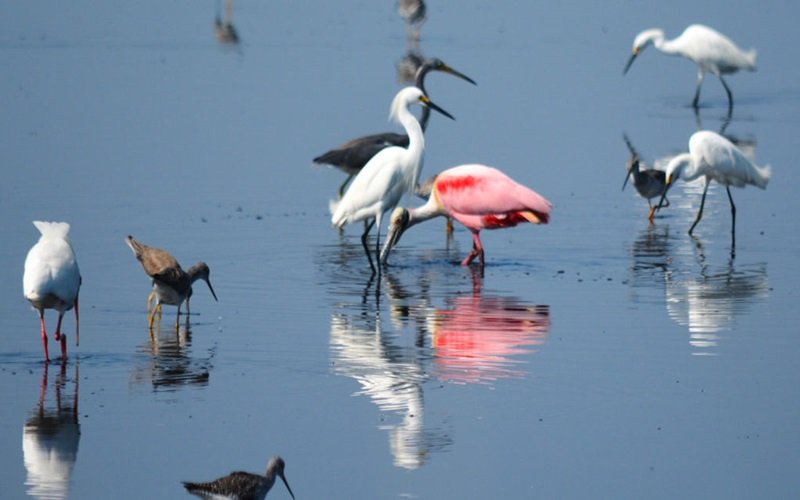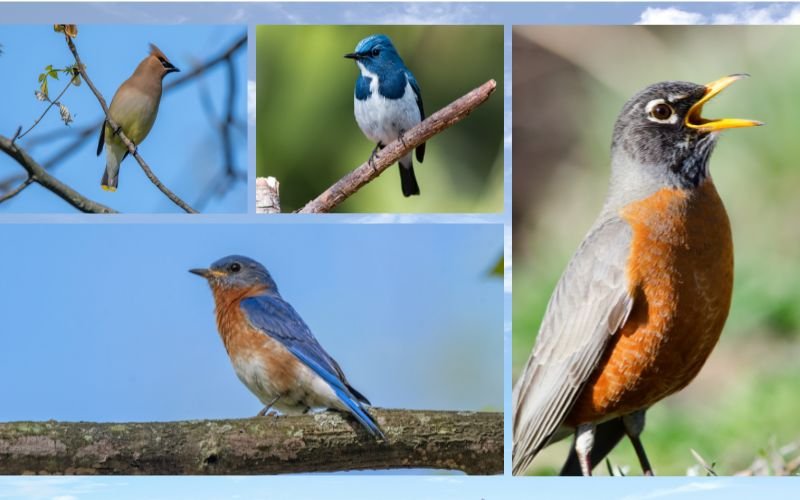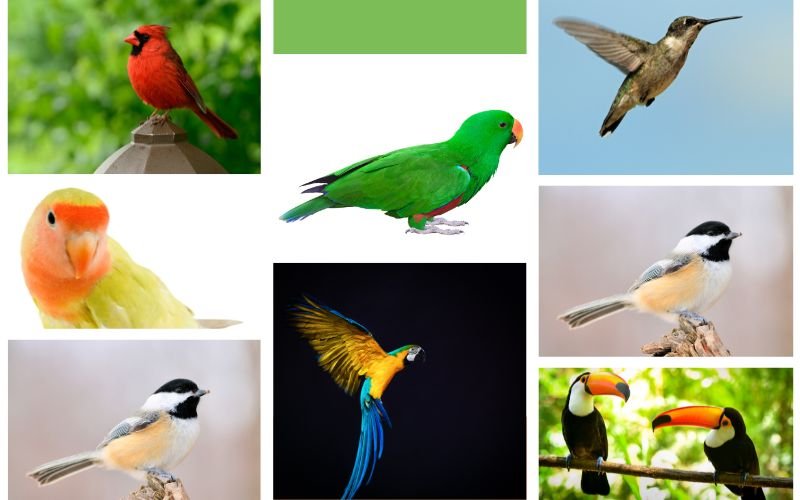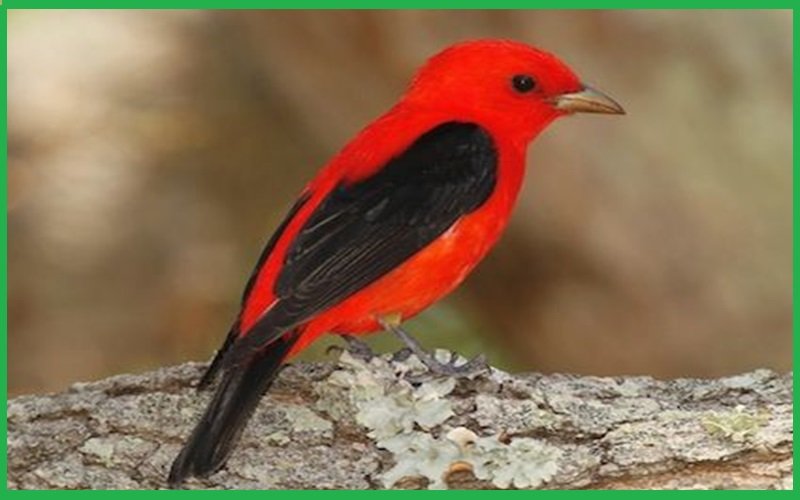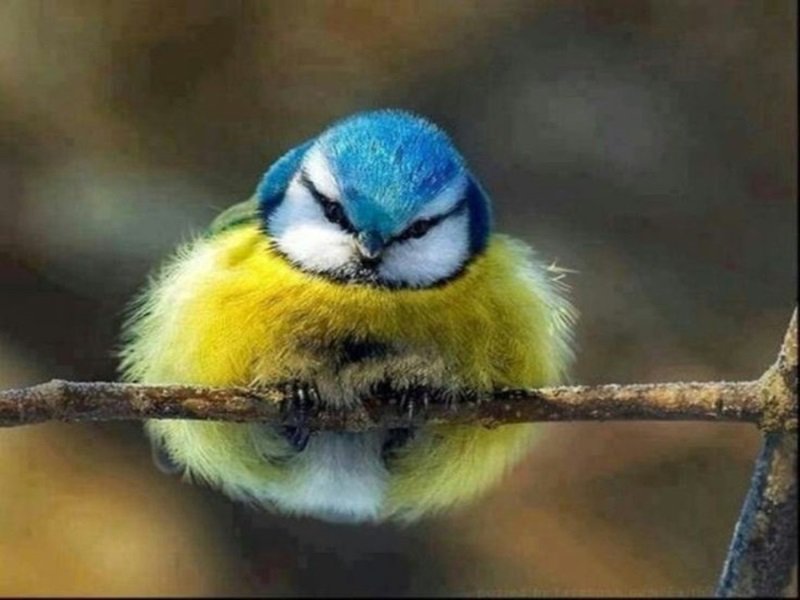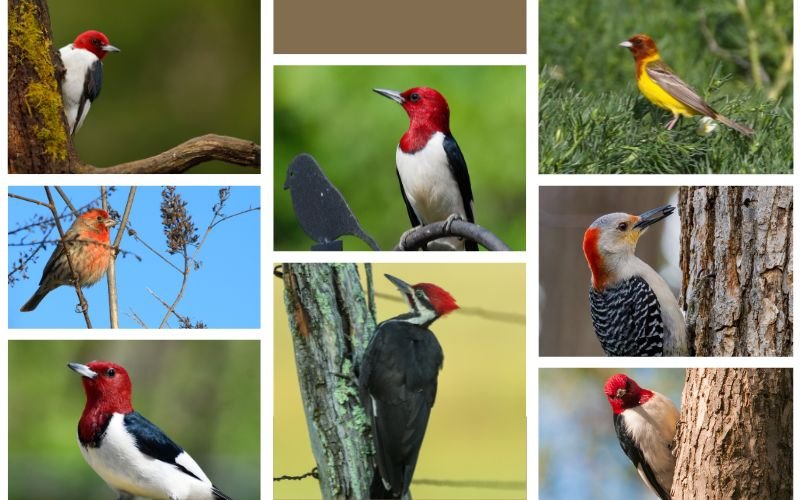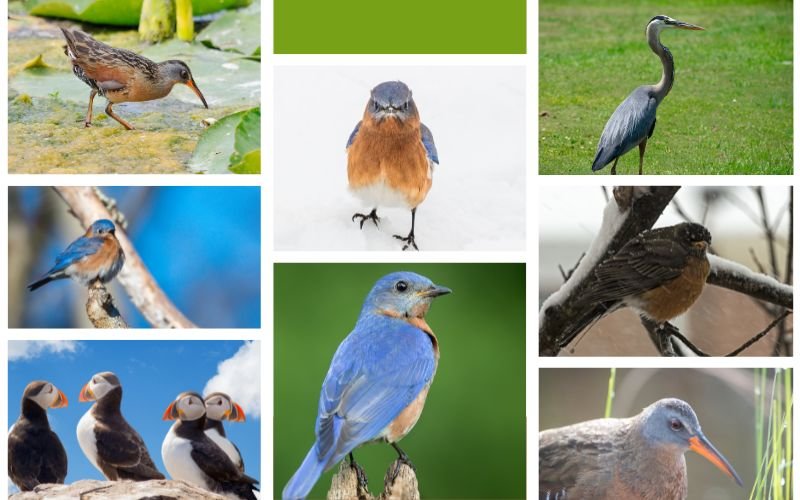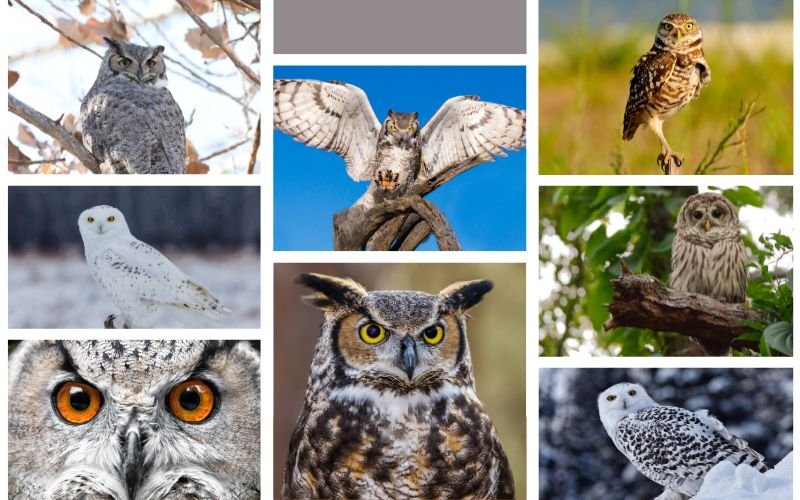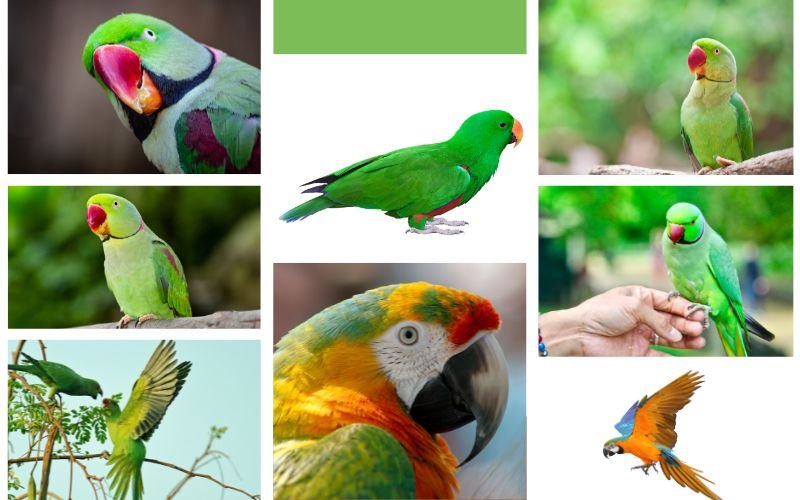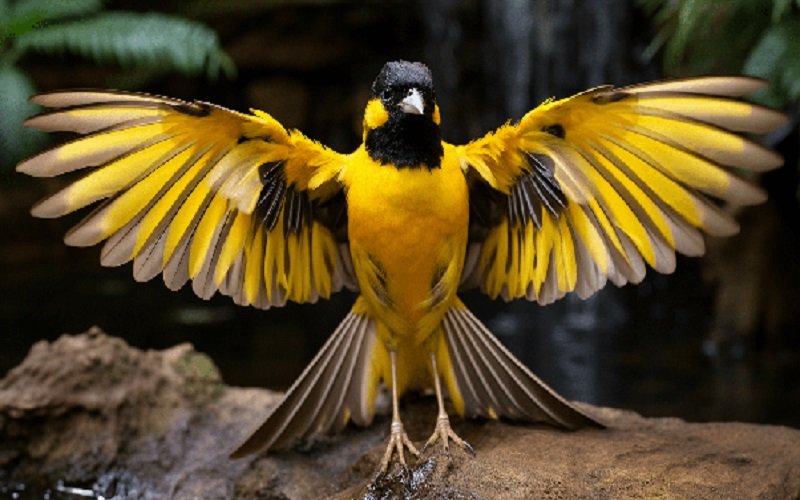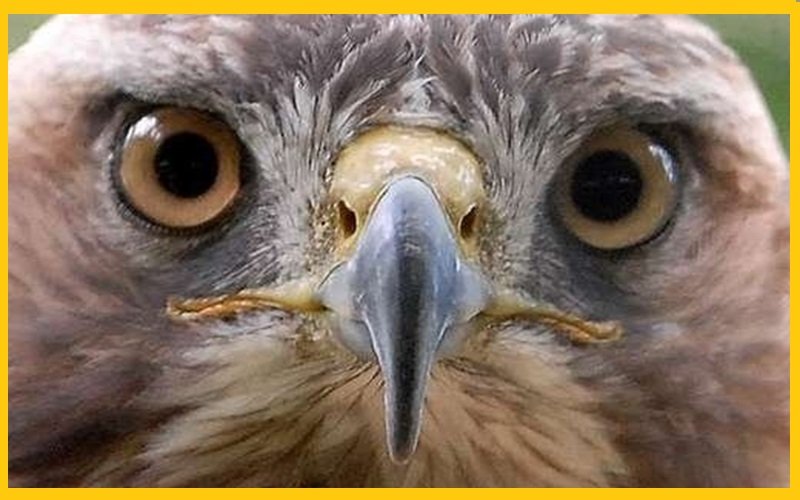Florida is a state in the southeastern part of the United States. Because of its economic development, it is considered the fourth-largest state in the US.
However, this state not only has an abundance of wealth but also countless collections of avian species because of diverse forests, beaches, and coral Islands.
In this article, I will provide my personal observations of the top 26 beach birds in Florida, along with their physical characteristics such as size, wingspan, lifespan, native place, food, scientific names, and other attributes of nature.
26 Types Of Florida Beach Birds
Florida City became the fourth-highest city in the US because of its geographical or regional distribution, which is filled with many fruits that our avian friends need.
Nonetheless, during my earlier vacation in Florida, I saw such amazing beach birds and observed their behavior patterns as a bird lover.
In this section, I will discuss the top 26 beach birds in Florida along with their scientific names, size, native places, lifespan, food or diet, and many other characteristics. So let’s not wait anymore.
1. American White Ibis
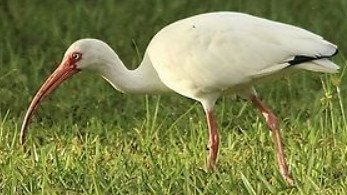
- Scientific name: Eudocimus albus
- Lifespan: 16 to 27 years
- Wingspan: 90-105 cm
- Native to: United States
- Food or Diet: crayfish, crustaceans, insects, small fish, crabs, larvae and beetles
American white ibis are large seabirds found in Florida, United States. They are fully white birds with large orange-curved bills and long orangish red legs.
Additionally, during their breeding season, these beach birds cover Virginia, the Gulf Coast, Baja California, the Atlantic Coast Carolinas, and Florida. Their habitat areas include coastal marshes, wetlands, mangrove areas, muddy pools, ponds, and flooded fields.
In summer, they usually shift to coastal areas where summer rains flood the areas. They choose these kinds of places because they can easily forage in the deep water and glide effortlessly.
These Florida beach birds become more territorial during their breeding season and nesting seasons. Sometimes, they also show some agonistic behavior, a kind of threat display for other species.
I have seen these beach birds consume crayfish, crustaceans, aquatic insects, small fish, crabs, and other small fish.
2. Laughing Gull
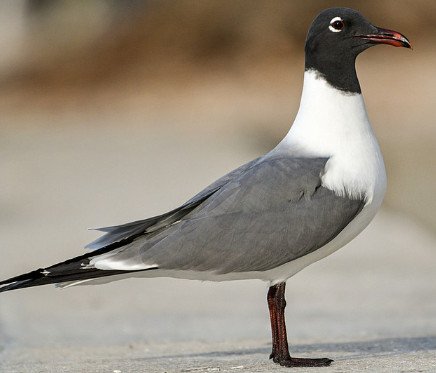
- Scientific name: Leucophaeus atricilla
- Lifespan: up to 22 years
- Wingspan: 98-110 cm
- Native to: North and South America
- Size: 14-16 inches
- Food or Diet: small fish, insects, earthworms, crustaceans, snails, etc.
Laughing gulls are the medium size beach birds related to the gull birds family. Talking about their appearances, these gull birds have dark gray backs and wings along with a black head and long red bills.
These Florida birds take a minimum of three consecutive years to become adults. They are highly visible throughout the North and South American regions, including the Atlantic coast, the Caribbean, and Florida.
In the winter season, they usually migrate more to the southern parts of the region. However, you will barely observe them in Western Europe.
Inside these distributional areas, these Florida beach birds prefer coastal marshes, ponds, and wetlands for their habitats. These Florida bluebirds usually build a large nest on the ground with grasses.
Female gulls lay 3 to 4 greenish eggs in the clutch and incubate the eggs. Usually, their diet contains small fish, insects, earthworms, snails, etc.
3. American Oystercatcher
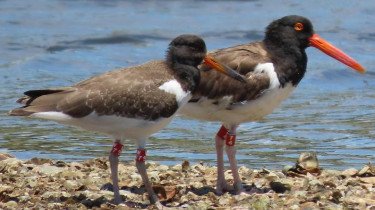
- Scientific name: Haematopus palliatus
- Lifespan: around 17 years
- Wingspan: 35 inches
- Native to: North America
- Size: 17-20 inches
- Food or Diet: mussels, clams, starfish, crabs, shellfish, mollusks, limpets etc.
American Oystercatchers are another beach bird of Florida, within the United States region. These birds have long red beaks and black heads, necks, and upper bodies.
Besides, their lower abdomen parts are white with nude pinkish legs. These birds are also identified as PiruPiru birds, American pied oystercatchers, or sea pies.
Their distributional regions cover the Atlantic Coast of North America, New England, northern Florida, the Caribbean, South Brazil, Uruguay, and Argentina. You can also find these Florida beach birds in California, Mexico, Central America, Peru, and Chile.
During their breeding season, they are spotted on the Atlantic and Gulf Coasts, and in winter, they travel to central New Jersey, the Gulf, and Mexico.
Like other beach birds, they also prefer marshes, wetlands, coastal areas, shell beaches, marsh beaches, salt marshes, and mudflat areas for their habitat.
During their migration period, you can spot them on shellfish beaches. Their breeding season starts in April and July where females lay 2 to 4 dark brown speckled eggs.
Both parents equally participate in the incubation process on alternate days up to 27 days. These birds’ eggs are well camouflaged, but sometimes they get hunted by other prey birds like crows, rats, foxes, and raccoons.
4. Black Skimmer
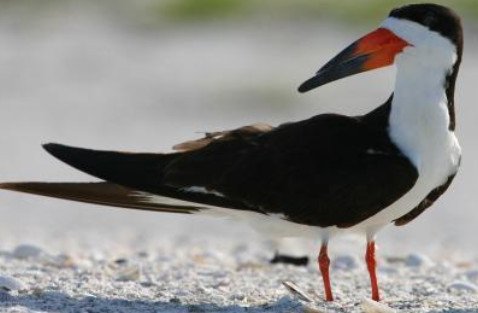
- Scientific name: Rynchops niger
- Lifespan: around 20 to 23 years
- Wingspan: 42 to 50 cm
- Native to: North and South America
- Size: 16 to 20 inches
- Food or Diet: small fish, insects, crustaceans and mollusks
Black skimmers are the other sea birds that are highly noticeable on Florida beaches, including North and South America.
These birds also migrate to northern regional surroundings in winter seasons and prefer tropical and subtropical Pacific coastal areas for their habitats. They also prefer sandbars, rivers, coasts, and lagoons for speeding times.
If you notice, you can observe their long, curved red bills and red legs. Besides, the body’s upper portion is black, mostly the edges of the wings, with white lower parts and foreheads.
These Florida beach birds tend to breed in groups with other colonial members. During their breeding seasons, they choose sandbanks and sandy beaches in the North American region, including Florida.
Female birds often lay 3 to 7 white spotted buff or bluish eggs in the clutch and incubate. Generally, both parents share their parental duty and incubate equally on behalf of each other absent.
These Florida beach birds consume insects, beetles, crustaceans, and mollusks for their diets.
5. Double Crested Cormorants
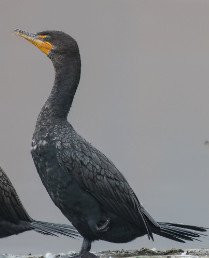
- Scientific name: Phalacrocorax auritus
- Lifespan: almost 20 years
- Wingspan: 45 to 48 inches
- Native to: North America, Alaska, Florida, and Mexico.
- Size: 28-35 inches
- Food or Diet: fish, amphibians, crustaceans, insects
The double-crested cormorant bird is a similar cormorant species widely distributed in Florida. They are also known as water birds because they prefer watery areas such as rivers, lakes, and coastal areas for their habitats.
Other than Florida state, they are also native to North America, Alaska, and Mexico. During their migration, I have seen them traveling from the coldest place, Canada, to Europe during their off-season.
Identified as water birds, these Florida beach birds are slow swimmers. They often swim where their head and neck are visible to the surface level of the water.
They can also dive about 4 feet to 25 feet deep inside the water. While diving, they stretched their wings, shook them, and let them dry before reaching shore.
6. Brown Pelicans

- Scientific name: Pelecanus occidentalis
- Lifespan: 30 years
- Wingspan: around 6.5 feet
- Native to: Atlantic, Gulf, and Pacific coasts in America
- Size: around 1 to 1.52 meters
- Food or Diet: fish such as pigfish, pinfish, mullets, sardines, crustaceans
The brown Pelicans are related to the subspecies of the pelican family. These brown Pelican birds are also known as beach birds of Florida state because of their decent amount of population.
I have observed that these birds have a yellow head and a black body and neck with a yellowish-brown combination.
Apart from Florida, state, They are also common in America, the Atlantic coasts, the Amazon River, Pacific Oceans, and Chile.
During their Non-breeding seasons, they migrate back to Canada. You can find these species in shallow water, salty bays, and beaches for their habitats because of their marine nature.
I have seen that 90% of their diet consists of fish. They can effortlessly spot their prey or any fish during their flying position.
And so, their nesting month is between March and April where the male choose their nesting sites and perform display dances for their partners.
7. Little Blue Heron
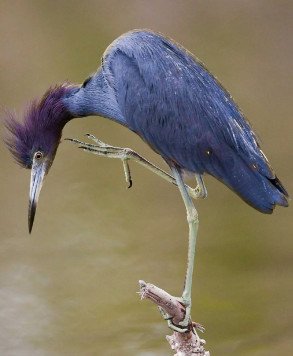
- Scientific name: Egretta caerulea
- Lifespan: 13 years 11 months (Around 14 years)
- Wingspan: 39 to 41 cm
- Native to: America, United States, South America
- Size: 22 to 29 inches
- Food or Diet: fish, insects, shrimps, amphibians, etc.
Little blue herons are other seabirds widely captured on Florida beaches, including those in the United States, South America, Canada, Central America, Mexico, Cuba, Colombia, and Venezuela regions.
You can easily spot these beautiful birds by their appearance. They have ashy blue bodies with purple maroon heads and long beaks, and their feet and legs are black.
They have unique hunting skills: They remain standing still on the water surface and wait for the prey to hunt them.
They avoid chasing the prey and catching them. Instead, they prefer a gradual walk towards their prey, moving slower to their target, and then grabbing the prey with their bills.
You can also find them nesting in colonies as they are colonial nesters. Both male and female Florida beach birds incubate the eggs in the clutch white sharing their parental duties.
8. Roseate Spoonbill
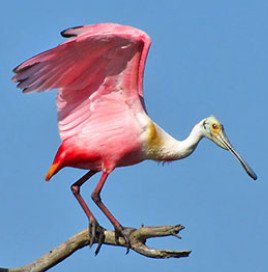
- Scientific name: Platalea ajaja
- Lifespan: around 10 years
- Wingspan: 47 to 52 inches
- Native to: South and North America
- Size: 71- 86 cm
- Food or Diet: small fish, frogs, mollusks, newts, insects, crustaceans, etc
Roseate spoonbills are large seabirds, a mixture of subspecies of both Ibis and spoonbill families. When talking about their physical appearances, their neck, back, and breasts are white, with greenish heads and pink-reddish wings.
One noticeable thing about these beach birds is that they have spoon-shaped bills that are flattened downwards.
Additionally, These Florida beach birds are widely scattered in Texas, Andes, the Caribbean, Mexico, and the Gulf of the United States apart from this state.
During their breeding seasons, they tend to migrate to Florida and the nearby city. They are fond of mangroves and watery areas for constructing their nests.
Their feathers get a deeper pinkish-red color during a particular seasonal period, which makes them look more stunning. In the winter season, they make flocks and roam with their community.
These beach birds also feed in shallow water by moving their beaks side to side. I have also overseen their adaptability; they can walk through the water to search for their prey.
9. Osprey
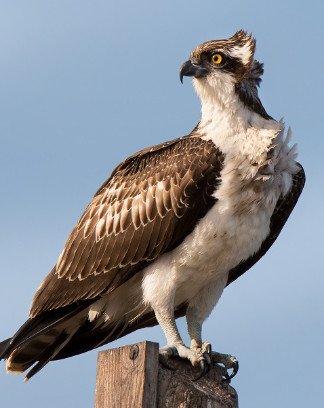
- Scientific name: Pandion haliaetus
- Lifespan: 7- 10 years
- Wingspan: 127–180 cm (50–71 in)
- Native to: north america, gulf coast, Florida, Alaska; except Antarctica
- Size: 50–66 cm (20–26 in)
- Food or Diet: prime food: fish; also eat rodents, frogs, birds, hares, rabbits, mammals, snakes etc.
Osprey hawks are also known as sea hawks, river hawks, or fish hawks in the state of Florida. During different seasons, they are widely distributed on the beaches of Florida, North America, Alaska, Newfoundland, the Gulf Coast, and Finland.
You can easily spot them if you notice that the lower parts of the bodies are deep, glossy brown with white breasts. Their heads are white with a dark brown patch across the eyes.
They have golden to brownish eyes and black bills. Note that you shouldn’t go to the Antarctica region, as these beach birds are very rare there.
I have seen them constructing their nests near watery places because these places are their best habitats.
These Florida beach birds made their nests in large heaps of sticks, driftwood, turf, tree forks, rocky outcrops, etc.
So, Female ospreys lay 2-4 eggs in the nests and raise their young there after successful breeding seasons. One interesting thing I have found out is that these beach birds prefer single mates for their whole lives until and unless their partner is dead.
10. Black-bellied Plover
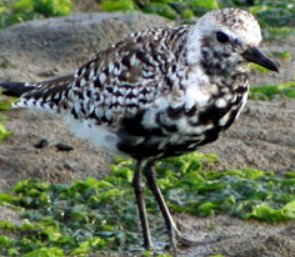
- Scientific name: Pluvialis squatarola
- Lifespan: about 20 years or more than that
- Wingspan: 71 to 83 cm
- Native to: North America
- Size: 27 to 30 cn
- Food or Diet: small mollusks, polychaete worms, crustaceans, and insects.
Black-bellied plovers are also highly recommended beach birds in Florida. These black-billed plovers are also known as Grey plovers in this beach area.
Adult Florida beach birds usually have spotted black and white backs and wings, along with a black face and white border. They usually molt during winter seasons from mid-August to early September.
These birds are usually long-distance migratory, generally covering coastal regions during their breeding season.
These beach birds are also found in the Arctic islands, the northern coast of Alaska, Canada, and Russia, in addition to the Florida region.
However, in dry open tundra, you may spot their habitats on the ground or surface level. They migrate to coastal areas like British Columbia, Argentina, and Chile.
They usually forage for food with their sight. However, in tidal flats, they also choose mollusks, worms, insects, crustaceans, etc., for their habitats.
11. Common Loon
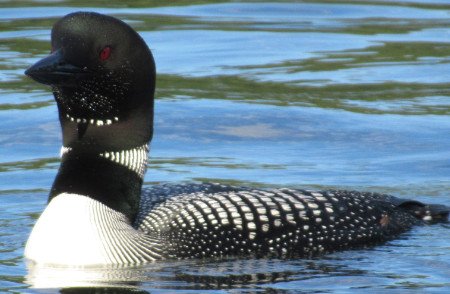
- Scientific name: Gavia immer
- Lifespan: around 30 years
- Wingspan: 127 to 147 cm
- Native to: United States, Mexico, Atlantic coast, Europe
- Size: 66 to 91 cm
- Food or Diet: fish, frogs, larvae, snails, crustaceans, crayfish, leeches, etc.
Common loons are other Florida beach birds that are highly distributed in the United States, Canada, Greenland, and Alaska. Their habitat covers wooded lakes and tundra ponds.
Usually, they migrate to those places of watery areas that do not freeze during winter seasons. However, these birds are extreme hunters of fish.
I have seen them diving 60 meters deep to catch their prey. During their breeding sedans, these beach birds of Florida become more territorial and aggressive towards other watery birds like geese and ducks.
Sometimes, they also attack other birds and intruders, which breaks their territories. Besides, I have seen them produce different vocal sounds during their hooting.
Each sound they make is an indirect message to their community flocks, where they try to communicate or signal other birds during danger. Usually, these beach birds construct 56 cm wide nests with mutual cooperation.
12. Least Sandpiper
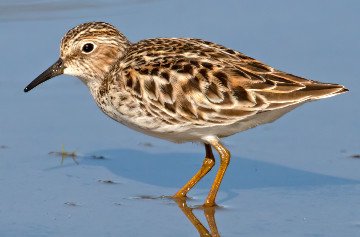
- Scientific name: Calidris minutilla
- Lifespan: up to 15 years
- Wingspan: 27 to 28 cm
- Native to: North America
- Size: 13 to 15 cm
- Food or Diet: small crustaceans, insects, snails, etc.
The least sandpipers are the smallest seabirds or beach birds of Florida City. These birds are mostly native to the North American region of tundra and bogs, including this city.
These Florida beach birds have small, greenish legs and small, thin bills. Adult sandpipers have brown plumage with steaks on the top of their bodies and white underneath.
Sometimes, you might get confused with them by other shorebirds. You will find their nests on the ground around the Florida beach areas. In those nests, female birds lay 4 eggs.
I have seen male and female sandpipers perform their parental duty together and incubate the eggs. Additionally, these beach birds of Florida tend to migrate in a community to the Southern United States, Mexico, Central America, and the Caribbean.
However, these Florida species are very rare in Europe and are rarely seen there. These birds mainly consume small crustaceans like insects and snails in their diets.
13. Ring-Billed Gull
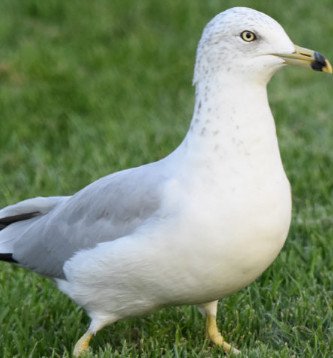
- Scientific name: Larus delawarensis
- Lifespan: around 10 years
- Wingspan: 105 to 117 cm
- Native to: America
- Size: 43 to 54 cm
- Food or Diet: insects, fish, grains, eggs, earthworms, rodents etc.
Ring-billed gulls are recognized as seabirds or beach birds in Florida City. Their origin covers America, Canada, Mexico, Atlantic, and Pacific coasts.
However, in winter, these beach birds usually migrate more to the south to Mexico on the Gulf, Atlantic, and Pacific coasts of North America.
Usually, these beach birds have white heads, necks, and white abdomens. Additionally, they have yellowish Irish and yellowish bills where the tips of their bills are black.
I have seen them finding habitats with more lakes and rivers. However, these birds also live in parking lots in large numbers. Their diets are fit, random questioning-making.
I have seen insects, grains, eggs, earthworms, etc. Sometimes, they fly very close to human interaction and accept food from their hands.
14. Sanderlings
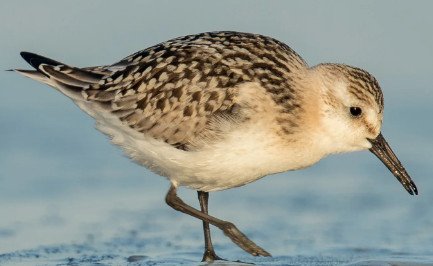
- Scientific name: Calidris alba
- Lifespan: around 13 years
- Wingspan: around 17 inches
- Native to: South America, South Europe, Africa, and Australia,
- Size: 7.1 to 8.7 inches
- Food or Diet: insects, crustaceans, fish, etc.
Sander lines are small wading birds that are highly noticeable in Florida cities and in North America, Europe, and Asia.
Their breeding regions cover Eurasia, Greenland, the Canadian Arctic, Nunavut, and Alaska. During the winter season, they usually inhabit sandy beaches, mudflats, stores, lakes, and rivers in the coastal region.
These Florida beach birds are also very aggressive while protecting their territories. Sometimes, they choose one mate for their successful breeding.
However, females occasionally have more than two pairings simultaneously to breed successfully.
Most adults leave for the breeding ground in July and August, whereas juvenile birds leave the place in late August and early September.
15. Sandwich Term
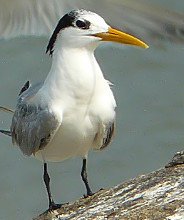
- Scientific name: Thalasseus sandvicensis
- Lifespan: 12 years
- Wingspan: 33 to 38 cm
- Native to: Europe, Caspian Sea, Africa, India, Sri Lanka
- Size: 37 to 43 cm
- Food or Diet: small fish, schooling fish, squid, shrimp, crustaceans, and insects.
Sandwich terns are related to the term family and are also considered beach birds of Florida. However, apart from Florida, these sandwich terns are also local to Europe, the Palearctic, the Caspian Sea, South Africa, India, and Sri Lanka.
In terms of physical appearance, these beach birds of Florida have gray and white plumage over their bodies with yellow-tipped long black bills. They also have black patches over their heads covering the forehead and eyes.
Their black crest becomes white in the winter season. They are considered among the most vocal beach birds.
Besides, these species mostly breed in dense colonies over the coastal Islands. Females build ground-shaped nests where they lay one to three eggs.
I have seen these birds become more aggressive when their nests get close to other species. They use incredible hunting techniques to catch their prey.
They swoop and dive down directly when they see prey. They also showcase this behavior during their courtship rituals.
16. Snow Egret
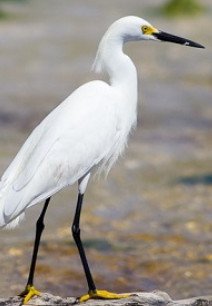
- Scientific name: Egretta thula
- Lifespan: around 16 to 17 years
- Wingspan: around 100 cm
- Native to: North and South America
- Size: about 56 to 66 cm
- Food or Diet: fish, crustaceans, crabs, shrimps, crayfish, insects, reptiles, lizards, snakes, snails, frogs and worms.
The snow egret is a small white bird with long black legs and bills and bright yellow feet. It is widely common in North and South America, Chile, and Argentina.
You can also find them as residents in the West Indies throughout the year. Thus, in those regions, they choose wetlands, marshes, riverbanks, lakeside, pools, and salt marshes for their habitats.
However, I have seen these migratory birds travel on long-distance journeys in winter seasons. Usually, these birds build their nests in a tree, unlike other Florida beach birds, where most birds construct their nests on the grounds.
Males mainly build territories and construct nests in trees; preferably, the environments are dense, thick, and vine-covered.
Later, female Florida beach birds lay around 6 pale bluish-green eggs and incubate them for about 24 days.
17. Spotted Sandpiper
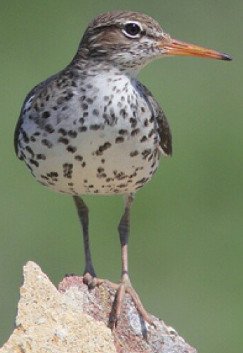
- Scientific name: Actitis macularius
- Lifespan: around 12 years
- Wingspan: 37 to 40 cm
- Native to: Canada and the United States
- Size: 18 to 20 cm
- Food or Diet: insects, invertebrates, grasshoppers, dragonflies, caterpillars, snails, spiders, mollusks, and worms.
Spotted Sandpipers are also small shorebirds highly distributed in Florida cities. In addition to this city, these birds’ locals are from Canada, the United States, the Caribbean, and South America.
However, you will not find them on European continents as they are rare species in this region. I have observed these birds choosing wetlands like marshes, riversides, ponds, and areas for their habitats.
These birds hardly make groups or flocks because these Florida beach birds like to roam alone in the wild. Female sandpipers spotted the breeding sites before the male.
Usually, males arrive late in their breeding seasons. But male builds their territory to protect and detect their areas from other breeding couples.
I have seen these bird species of Florida become more competitive in finding their mates than other birds.
These birds eat mostly flies, beetles,grasshoppers, mayflies, caterpillars, spiders, snails, mollusks, and worms.
18. Western Sandpipers
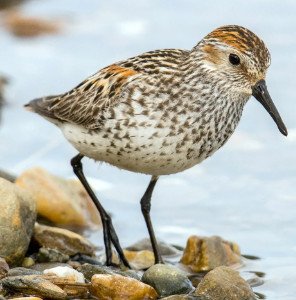
- Scientific name: Calidris mauri
- Lifespan: 7 years
- Wingspan: 35 to 37 cm
- Native to: North America
- Size: 14 to 17 cm
- Food or Diet: insects, spiders, small crustaceans, mollusks, worms, and seeds
Western sandpipers are other seabirds that are a subspecies of sandpiper birds. These birds have brownish-white upperparts and white bottoms with sharp bills.
These birds are mostly native to North America, South America, and the Caribbean, including Florida Beach. In those areas, they inhabit the tundra on the eastern side of Siberia and the Alaska region.
Nonetheless, you can spot them migrating to North and South America, including the Caribbean. However, like other Florida beach birds, they are also very hard-spotted on European continents.
Besides, these Florida beach birds are considered to have one of the highest population birds among shorebirds.
Later, talking about their diet, I saw them mostly eating insects, spiders, small crustaceans, mollusks, seeds, etc for their diet.
19. Willet
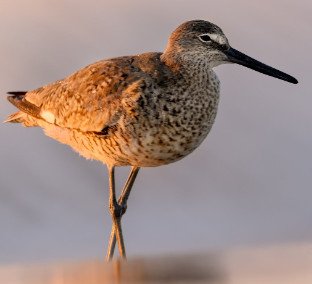
- Scientific name: Tringa semipalmata
- Lifespan: around 10 years
- Wingspan: 70 cm
- Native to: America
- Size: 12 to 16 inches
- Food or Diet:
The Willets are large shorebirds or beach birds native to Florida Beach. They are also found in North America, South America, Central America, and the West Indies.
These birds breed mostly in North America and the West Indies and later migrate to the southern part of the country, such as southern North America, Central America, and South America.
However, these Florida beach birds prefer coastal fresh marshes, and wetlands, unlike Eastern wallets, which prefer salt marshes during their breeding seasons.
You can capture these birds perching on a tree, rocks, or any fence post. During their breeding seasons, males guide females through their nests, and later, females select the nests and nesting sites.
Usually, these birds construct their nests with grasses and sand dunes. They are identified as nervous birds with their surroundings. Both male and female Florida birds incubate the eggs.
Males tend to incubate at night while defending their territory as well.
20. Yellow-Crowned Night Heron
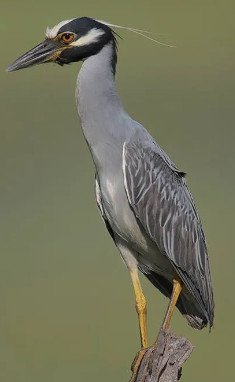
- Scientific name: Nyctanassa violacea
- Lifespan: average 6 years
- Wingspan: 101 to 112 soja.
- Native to: America
- Size: 55 to 70 cm
- Food or Diet: crabs, crayfish, insects, worms, wolves, etc.
Yellow-crowned night herons are a subspecies of the night heron family. These birds have smooth gray-blue bodies and backs, along with head crests.
They also contain glossy blackheads, white bars near the eyes’ side, and pale-colored bill-snapping red legs. Additionally, these night heron birds are highly distributed in North America.
However, they migrate to different regions to find food. Usually, their migration occurs between mid-March and April. The distribution places are thoroughly dependent on the availability of local food.
They usually make loud, sharp voices, and sometimes, these calls refer to threatening or aggressive behavior. Besides all of this, you may spot these night heron birds perching between day and night.
I have seen them swallow their whole prey at once. But if their prey size consequently becomes large, they eat the body first and later go for the legs.
These birds comprise one brood per year and females lay 2 to 6 oval smooth eggs in the clutch. These yellow-crowned Florida beach birds have insects, fish, worms, crabs, snails, and lizards in their habitats.
21. Tricolored Heron

- Scientific name: Egretta tricolor
- Lifespan: around 17 years
- Wingspan: 96 cm
- Native to: coastal parts of America
- Size: 56 to 76 cm
- Food or Diet: mostly fish, arthropods, prawns, etc.
Tricolored herons are beach birds in Florida and are considered the second-largest population of herons in the United States.
In addition to this state, they are very familiar with the coastal areas of America, such as the Gulf of Mexico, the Caribbean, Brazil, Peru, California, etc.
These birds generally have large necks, and long legs, with long, pointed, yellowish-grayish bills. Their feet and legs are comparatively dark with a blue-gray head, black upperparts, and white lower belly.
You can spot these birds in swamps and coastal habitats, where they usually make their nests with sticks, trees, or shrubs. Later, females lay 3 to 7 eggs in a clutch and incubate them.
When they hunt or detect their prey, they usually hide themselves in bigger flocks so that they can suddenly attack it. Their maximum diet consists of crabs, but they also occasionally eat arthropods.
22. Ruby Turnstone
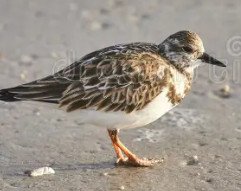
- Scientific name: Arenaria interpres
- Lifespan: around 6 to 7 years
- Wingspan: 50 to 57 cm
- Native to: Eurasia and North America
- Size: 22 to 24 cm
- Food or Diet: Carrion, fish, invertebrates, insects, worms, spiders, crustaceans, mollusks, etc.
Ruddy turnstones also reside in Florida cities throughout the year. Besides this city, they are also native and bred in North America, Europe, and Asia.
Afterward, they were spotted migrating to the South Coastlines in winter. If you notice, you will observe that their upper body plumage is brownish black, and lower parts are white with red legs and black bills.
These Florida beach birds are known for their aggressive behavior while defending their territories. However, they are also loyal to their partners because they remain stuck together for a particular breeding season.
They make their nests usually 11 cm wide and 3 cm deep. Females incubate the eggs for maximum times. However, males take part for a couple of days in the process. After hatching, the young tend to leave the nest around 19 to 21 days.
23. Reddish Egret
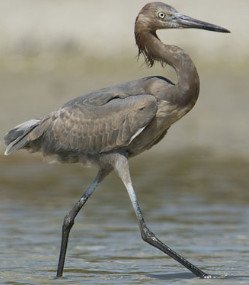
- Scientific name: Egretta rufescens
- Lifespan: up to 12 years
- Wingspan: 46 to 49 inches
- Native to: Central America
- Size: 27 to 32 inches
- Food or Diet: insects, invertebrates, snails, worms, snakes, lizards, frogs, crustaceans etc.
Reddish egrets are also one for the beach birds or shorebirds in Florida. Besides this city, they are also very familiar with Central America, the Bahamas, the Gulf Coast of the United States, and Mexico.
The egret’s face and neck are longer, with reddish-brown plumage, and the wings have grayish-blue plumage. It also has long blue legs and pinkish bills.
These Florida beach birds are among the most active herons. They tend to move around and be playful in their environment.
Their favorite food is fish, frogs, crustaceans, and insects. They also showcase amazing courtship behavior with their partners.
Usually, these birds shake their heads during their greeting sessions and also raise feathers, raising their neck and backs. Sometimes they chased or followed other flocks in a circle to find out their mates.
24. Red Knot
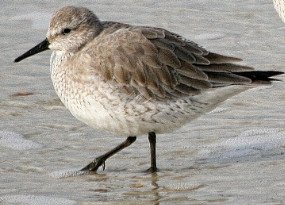
- Scientific name: Calidris canutus
- Lifespan: around 15 years
- Wingspan: 19 to 21 inches
- Native to: Canada, Europe, Russia
- Size: 9.1 to 10.2 inches
- Food or Diet: mostly spiders, mussels, gastropods, small crabs, etc.
Red knots are another seabird highly observable in Florida cities, including northern Canada, Europe, and Russia. In these regions, they tend to inhabit tundra and Arctic areas that are marginalized in coastal areas.
These birds have a brownish back with a small round head and long bills. They also have white bellies In the non-breeding seasons.
During the breeding seasons, their face, neck and lower body has reddish plumage as well. Theybm can migrate up to 9,000 miles away from their breeding areas that’s why they are also identified as long distance migratory birds.
They are considered a risk species because of their habitual loss and deforestation. Most of their diet consists of spiders.
However, in different seasons, they consume mussels, gastropods, crabs etc. They also have special ability to detect their prey from the muddy areas and can capture them.
25. Magnificent Frigatebird
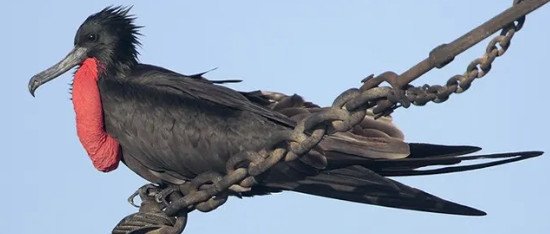
- Scientific name: Fregata magnificens
- Lifespan: around 30 years
- Wingspan: 2.17 to 2.44 m
- Native to: America
- Size: 89 to 114 cm
- Food or Diet: mainly fish, squid, jellyfish, crustaceans
Magnificent frigatebirds are large seabirds in Florida. These birds usually have a throat punch resembling a balloon during their breeding seasons.
Their features are black with a purple shine on it along with blue eye rings, brown patches on the wings. These birds can fly around 2,500 m above the surface.
These large Florida beach birds make their shallow platform nests on a tree with mangroves. Besides, the female birds lay one fresh egg on the clutch, and both parents incubate the eggs on particular days for up to 50 to 60 days.
Later, when the egg hatches, the male parent leaves or abandons the nest. For a time period, female parents stay with the child until around one year later, when she also leaves the nest.
Their diet consists mostly of fish; apart from that, they consume jellyfish, squid, and crustaceans.
Conclusion
On a final note, Florida is a city of nature for avian species, which has abundant wealth in nature and the ecological environment.
Through my experiences in Florida, I have explored these 26 beach birds of this state and emphasized that each and every factor makes this city a heavenly place for our amazing beach birds or shorebirds by helping them with their successful breeding, nesting, and hunting along with providing them with enough food sources and protection.

